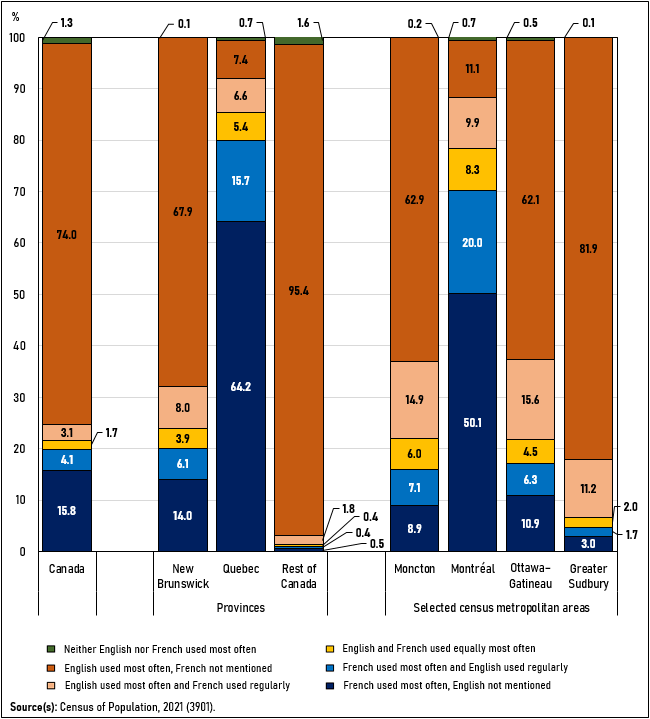Infographic 7
English and French are the languages of convergence at work in Canada

Infographic description
The title of the infographic is "English and French are the languages of convergence at work in Canada"
This is a stacked bar chart.
Each bar is divided into segments that represent the percentage of workers who use French or English at work.
One bar shows the results for Canada, while the other bars show the results for selected provinces (New Brunswick, Quebec and the rest of Canada) and selected census metropolitan areas (Moncton, Montréal, Ottawa–Gatineau and Greater Sudbury).
For each bar, the segments are as follows: "French used most often, English not mentioned"; "French used most often and English used regularly"; "English and French used equally most often"; "English used most often and French used regularly"; "English used most often, French not mentioned"; and "Neither English nor French used most often."
In Canada, 15.8% of workers were in the category "French used most often, English not mentioned"; 4.1% in the category "French used most often and English used regularly"; 1.7% in the category "English and French used equally most often"; 3.1% in the category "English used most often and French used regularly"; 74.0% in the category "English used most often, French not mentioned"; and 1.3% in the category "Neither English nor French used most often."
In New Brunswick, 14.0% of workers were in the category "French used most often, English not mentioned"; 6.1% in the category "French used most often and English used regularly"; 3.9% in the category "English and French used equally most often"; 8.0% in the category "English used most often and French used regularly"; 67.9% in the category "English used most often, French not mentioned"; and 0.1% in the category "Neither English nor French used most often."
In Quebec, 64.2% of workers were in the category "French used most often, English not mentioned"; 15.7% in the category "French used most often and English used regularly"; 5.4% in the category "English and French used equally most often"; 6.6% in the category "English used most often and French used regularly"; 7.4% in the category "English used most often, French not mentioned"; and 0.7% in the category "Neither English nor French used most often."
In the rest of Canada (outside New Brunswick and Quebec), 0.5% of workers were in the category "French used most often, English not mentioned"; 0.4% in the category "French used most often and English used regularly"; 0.4% in the category "French and English used equally most often"; 1.8% in the category "English used most often and French used regularly"; 95.4% in the category "English used most often, French not mentioned"; and 1.6% in the category "Neither English nor French used most often."
In Moncton, 8.9% of workers were in the category "French used most often, English not mentioned"; 7.1% in the category "French used most often and English used regularly"; 6.0% in the category "English and French used equally most often"; 14.9% in the category "English used most often and French used regularly"; 62.9% in the category "English used most often, French not mentioned"; and 0.2% in the category "Neither English nor French used most often."
In Montréal, 50.1% of workers were in the category "French used most often, English not mentioned"; 20.0% in the category "French used most often and English used regularly"; 8.3% in the category "English and French used equally most often"; 9.9% in the category "English used most often and French used regularly"; 11.1% in the category "English used most often, French not mentioned"; and 0.7% in the category "Neither English nor French used most often."
In Ottawa–Gatineau, 10.9% of workers were in the category "French used most often, English not mentioned"; 6.3% in the category "French used most often and English used regularly"; 4.5% in the category "English and French used equally most often"; 15.6% in the category "English used most often and French used regularly"; 62.1% in the category "English used most often, French not mentioned"; and 0.5% in the category "Neither English nor French used most often."
In Greater Sudbury, 3.0% of workers were in the category "French used most often, English not mentioned"; 1.7% in the category "French used most often and English used regularly"; 2.0% in the category "English and French used equally most often"; 11.2% in the category "English used more often and French used regularly"; 81.9% in the category "English used most often, French not mentioned"; and 0.1% in the category "Neither English nor French used most often."
Source(s): Census of Population, 2021 (3901).
- Date modified: